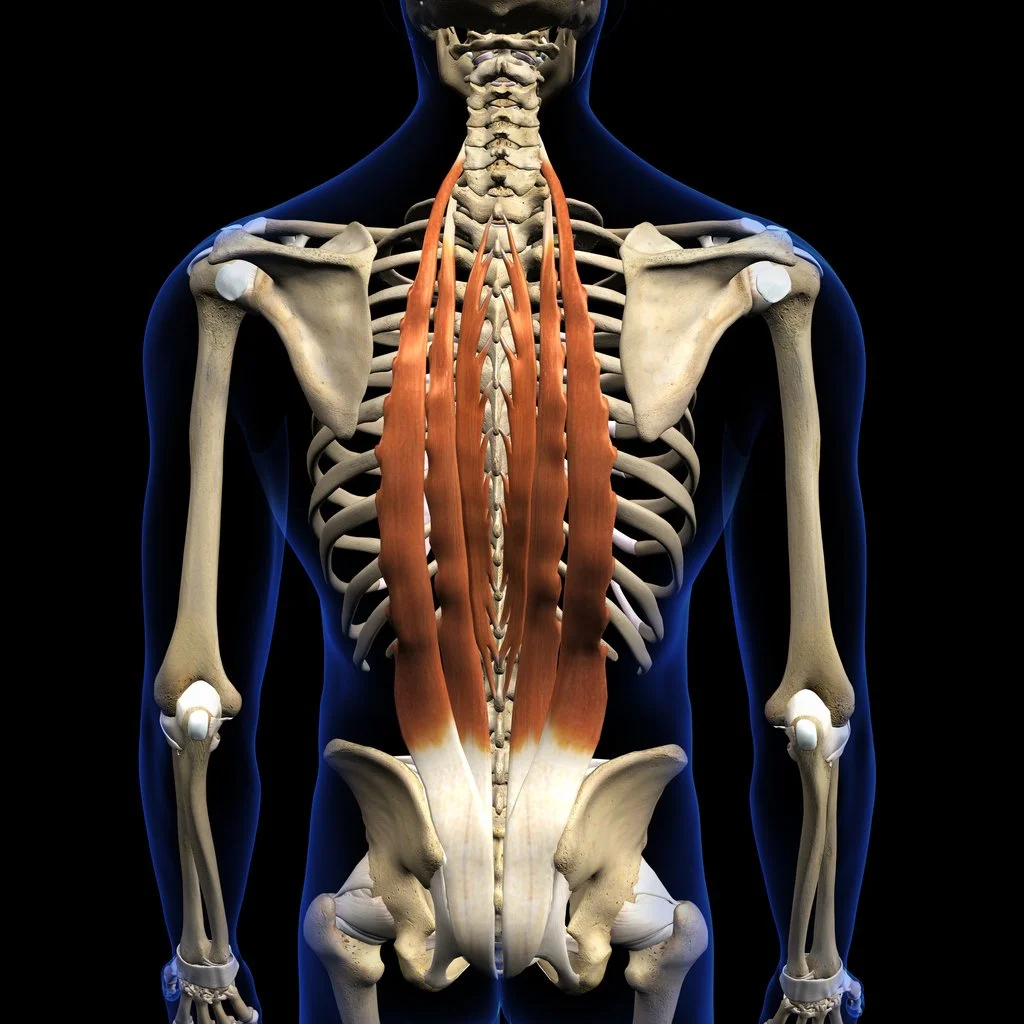Muscle Breakdown: Erector Spinae
Table of Contents
What Is the Erector Spinae
The Erector Spinae is a group of muscles that run vertically beside the spine. Composed of the Iliocostalis, Longissimus, and Spinalis, this muscle group is also known as the ‘I like standing’ muscles due to their function.
Erector Spinae Muscles
Three main muscles compose the Erector Spinae. The Iliocostalis, Longissimus, and Spinalis. Each of these muscles is further split into three additional muscles.
Iliocostalis
Iliocostalis Cervicis
Iliocostalis Thoracis
Iliocostalis Lumborum
Longissimus
Longissimus Capitis
Longissimus Cervicis
Longissimus Thoracis
Spinalis
Spinalis Capitis
Spinalis Cervicis
Spinalis Thoracis
Erector Spinae Function
The Erector Spinae has multiple functions including keeping the back upright, and extension of the back. They also rotate the spine laterally and are responsible for lateral back flexion.
Specifically, the Iliocostalis allows you to bend laterally and extend your back. The Longissimus is the largest of the three muscles and also allows you to bend laterally and extend your back. The Longissimus also allows for the lateral movement of the head. The Spinalis is the smallest of the Erector Spinae and allows the head to rotate, turn and look up.
Iliocostalis Function
The muscles of the Iliocostalis bilaterally contract to perform lumbar flexion. The muscles of the Iliocostalis also unilaterally contract to perform lateral flexion ipsilaterally.
Where Is The Iliocostalis Muscle Located
The Iliocostalis is located in the back on both sides of the spine.
Iliocostalis Innervation
The Iliocostalis is innervated by the Dorsal Rami of the Spinal Nerves.
Erector Spinae Origin
Iliocostalis
Angle of the ribs
Iliac Crest
Longissimus
Transverse process C4-T5
Sacrum
Iliac Crest
Spinalis
Spinous processes (Cervical and Thoracic)
Erector Spinae Insertion
Iliocostalis
Angle of the Ribs
Cervical and Lumbar Transverse Processes
Longissimus
Mastoid Process
Transverse Process of C2-C6
Transverse Process of T1-T12
Transverse Process L1-L5
Spinalis
Spinous Processes of the Cervical Vertebrae
Iliocostalis Cervicis
The Iliocostalis Cervicis originates from the angle of ribs three to six. The Iliocostalis Cervicis inserts into the Transverse Processes of C4-C6.
Iliocostalis Thoracis
The Iliocostalis Thoracis originates from the angle of ribs seven to twelve. The Iliocostalis Thoracis inserts into the angle of the ribs and the Transverse Process of C7.
Iliocostalis Lumborum
The Iliocostalis Lumborum originates from the medial Iliac Crest, Lateral Sacrum and the Thoracolumbar Fascia. The Iliocostalis Lumborum inserts into the angle of the ribs and the Transverse Processes of L1-L4.
Erector Spinae Pain
As with any muscle, pain in the Erector Spinae can be the result of injury, strain, overuse or muscle weakness. The onset of muscle pain can be indicative of a change occurring in the muscle. Remember to listen to your body and take time off or see a health professional to identify why pain is occurring and what the best treatment option is. Being proactive and taking preventative measures will help to reduce injury in the long term.
Erector Spinae Strain
Overstretching or tearing a muscle can be referred to as a muscle strain. The Erector Spinae muscles are commonly strained and could be from incorrect loading of the muscle group. This is why it is important to lift heavy objects from your knees and not the spine. Proper lifting techniques can help to avoid strains of the Erector Spinae group.
After an Erector Spinae strain, muscle spasms can occur as a protective mechanism. These spasms can manifest themselves as cramps, pain, or uncontrolled contractions. Before activity, it is important that you perform a proper warm-up and stretching to avoid muscle spasms. Proper strengthening of the Erector Spinae muscles can also help to avoid spasms and decrease the potential for future injury.
Erector Spinae Injury Prevention
Injury prevention is not just important for athletes, but also employees, caretakers, and anyone who repeats specific movements throughout the day. Those who are constantly lifting objects and have bad posture should be focused on preventing injury to the Erector Spinae.
Try taking breaks throughout your day to give your muscles a chance to rest. Be mindful of your posture and frequently stand up to avoid muscle tightness. Learning proper lifting techniques and having good posture can be beneficial in preventing injury.
Even better, strengthening the Erector Spinae muscle group and performing daily stretching is the best way to prevent injury! Performing activities that work on muscular strength can also help you to manage your weight and increase balance and stability when performed consistently over time.
Iliocostalis Syndrome
Iliocostalis Syndrome is when there is pain in the anterior torso. It can be caused by the ribs rubbing against the Iliac crest, which creates friction and pain in the side of the torso. Anti-inflammatories can help to reduce pain, as well as ice and stretching or strengthening exercises. Not much is known about other causes of Iliocostalis Syndrome. In some cases, chronic pain can be experienced in this region without any explanation as to why.
Erector Spinae Exercises
Back Extension
Using a back-extension machine, hook your legs into the proper position. Bend over so that your hips are forming a 45-90-degree angle with your legs. Engage your core to extend your back so that you are elevated in the machine. Pause at the top when you are fully extended and then slowly lower yourself back down. Repeat this movement for 3 sets of 10 reps.
Erector Spinae Stretch
Cat Camel
Cat Camel
Begin on your hands and knees on a yoga mat. Your hands should be underneath your shoulders and your knees should be underneath your hips. Arch your back by rounding your shoulders and elevating your rib cage. Hold this position for 2-3 seconds. Return to your original position by lowering your abdominals towards the floor so that there is a small ‘U’ shaped curve in your back. Repeat this movement pattern 5-10 times.


